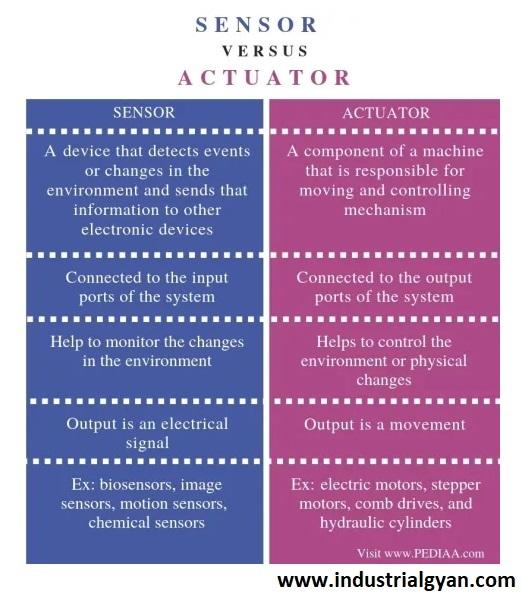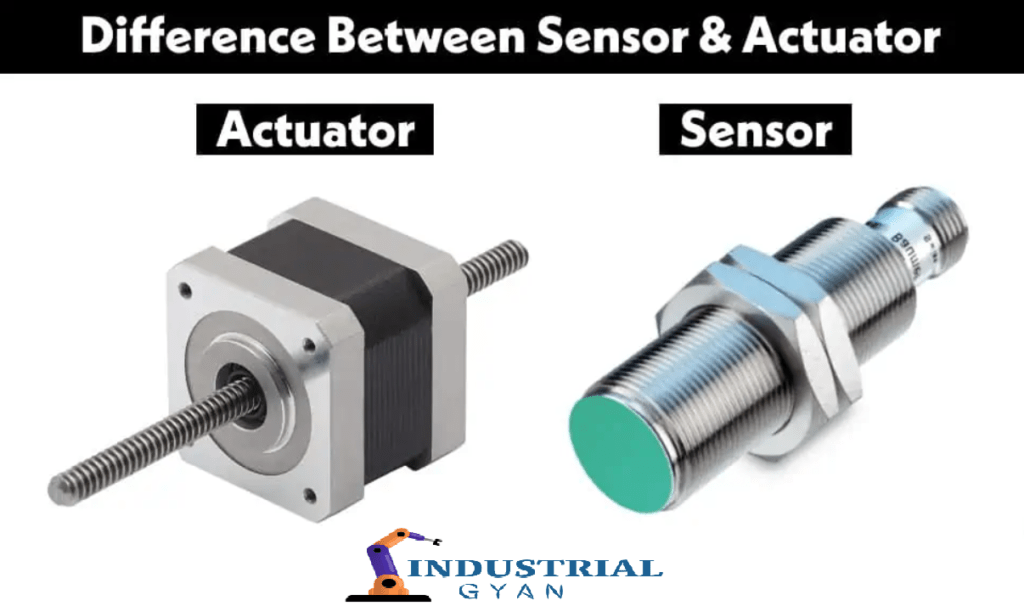Introduction
In the realm of technology, difference between sensor and actuator, play pivotal roles, serving as key components in various systems and devices. While these terms may sound similar, they have distinct functions and applications. In this article, we will delve into the fascinating world of sensors and actuators, exploring their differences, working principles, and applications across different industries. So, let’s dive in and uncover the intricate details that set these two technological marvels apart.
Difference between Sensor and Actuator: Unveiling the Distinctions
What is a Sensor?
A sensor is a device that detects and measures physical, chemical, or environmental parameters. It converts the measured information into an electrical signal, providing crucial data for analysis and control purposes. Sensors are like the eyes and ears of a system, perceiving the world around them.
Types of Sensors
Sensors come in various types, each designed to sense specific parameters. Some common types of sensors include:
- Temperature sensors
- Pressure sensors
- Proximity sensors
- Accelerometers
- Light sensors
- Gas sensors
What is an Actuator?
An actuator, on the other hand, is a device responsible for converting electrical signals into mechanical action. It receives signals from a control system and produces physical movement or manipulation in response. Difference Between Shell type and Core type Transformer Actuators act as the muscles of a system, enabling it to interact with the environment.

Types of Actuators
Actuators are available in various forms, with each type serving specific purposes. Some common types of actuators include:
- Electric actuators
- Pneumatic actuators
- Hydraulic actuators
- Piezoelectric actuators
- Thermal actuators
How Do Sensors and Actuators Work?
Working Principle of Sensors
Sensors work based on different principles depending on their type. However, most sensors operate by detecting a change in physical or environmental properties and converting it into an electrical signal. Here’s a general overview of how sensors work:
- Sensing:- The sensor detects a physical change, such as temperature, pressure, or light intensity.
- Transduction:- The sensor converts the physical change into an electrical signal.
- Conditioning:- The electrical signal is amplified, filtered, or processed to enhance accuracy and compatibility with the control system.
- Output:- The sensor delivers the processed electrical signal to the control system for further analysis or action.
Working Principle of Actuators
Actuators, on the other hand, function by transforming electrical energy into mechanical energy or physical movement. Insulation class Here’s a simplified explanation of the working principle of actuators:
- Input:- The actuator receives an electrical signal from a control system.
- Conversion:- The electrical energy is converted into mechanical action, such as linear or rotational movement.
- Output:- The actuator produces the desired physical response or movement, influencing the system or device it is connected to.

Applications of Sensors and Actuators
Applications of Sensors
Sensors find applications across various industries and fields. Here are some notable examples:
- Automotive industry:- Sensors are used in engine management systems, airbag deployment systems, and tire pressure monitoring systems.
- Healthcare:- Sensors play a vital role in medical devices like heart rate monitors, blood glucose meters, and body temperature measurement devices.
- Environmental monitoring:- Sensors are used to measure and monitor air quality, water pollution levels, and weather conditions.
- Industrial automation:– Sensors are employed in automated systems for quality control, position sensing, and object detection.
Applications of Actuators
Actuators also have diverse applications across multiple industries. Some common examples include:
- Robotics:- Actuators are essential components of robotic systems, enabling precise movement and manipulation.
- HVAC systems:– Actuators control the flow of air, water, or gas in heating, ventilation, and air conditioning systems.
- Automotive industry:– Actuators are used in systems such as power windows, power steering, and automatic door locks.
- Aerospace:- Actuators are critical for controlling various functions in aircraft, such as wing flaps and landing gear.
FAQs about the Difference between Sensors and Actuators
FAQ 1: What is the primary difference between a sensor and an actuator?
Sensors detect and measure physical or environmental parameters, while actuators convert electrical signals into mechanical action or physical movement.
FAQ 2: Can a sensor function as an actuator and vice versa?
No, sensors and actuators have distinct functions and are designed for specific roles. However, some devices may integrate both functions to achieve the desired outcome.
FAQ 3: Are sensors and actuators used together in most systems?
Yes, sensors and actuators often work in conjunction to create a closed-loop system, where the sensor detects changes and the actuator responds accordingly.
FAQ 4: Are sensors and actuators only used in industrial applications?
No, sensors and actuators are utilized in various industries, including automotive, healthcare, consumer electronics, and many others.
FAQ 5: Can you provide examples of systems where sensors and actuators work together?
Certainly! An excellent example is an automatic door system. The sensor detects the presence of a person, and the actuator opens or closes the door accordingly.
FAQ 6: How are sensors and actuators advancing technology?
Sensors and actuators advancements enable the development of intelligent systems, automation, and the Internet of Things (IoT), revolutionizing industries and enhancing efficiency.
Conclusion
In conclusion, understanding the difference between sensors and actuators is crucial to comprehend their individual roles and applications. Sensors serve as the eyes and ears of a system, detecting and measuring physical or environmental parameters. Actuators, on the other hand, act as the muscles, converting electrical signals into mechanical action or physical movement. Together, they form the backbone of modern technology, enabling automation, intelligent systems, and advancements in various industries. By grasping the unique functions of sensors and actuators, we can fully appreciate their contributions to our ever-evolving world of technology.
You can follow us on LinkedIn

I am a highly motivated and skilled individual with a passion for Electrical engineering. I have 1 year of experience in Robotics and Electrical engineering, which has allowed me to develop a strong set of skills in PLC, Painting Robots, SCADA. I am a quick learner and am always looking for new challenges and opportunities to expand my knowledge and skills. I am a team player and enjoy working with others to achieve a common goal. Successfully completed many projects for a various clients in the automobile sector.
Thank You

